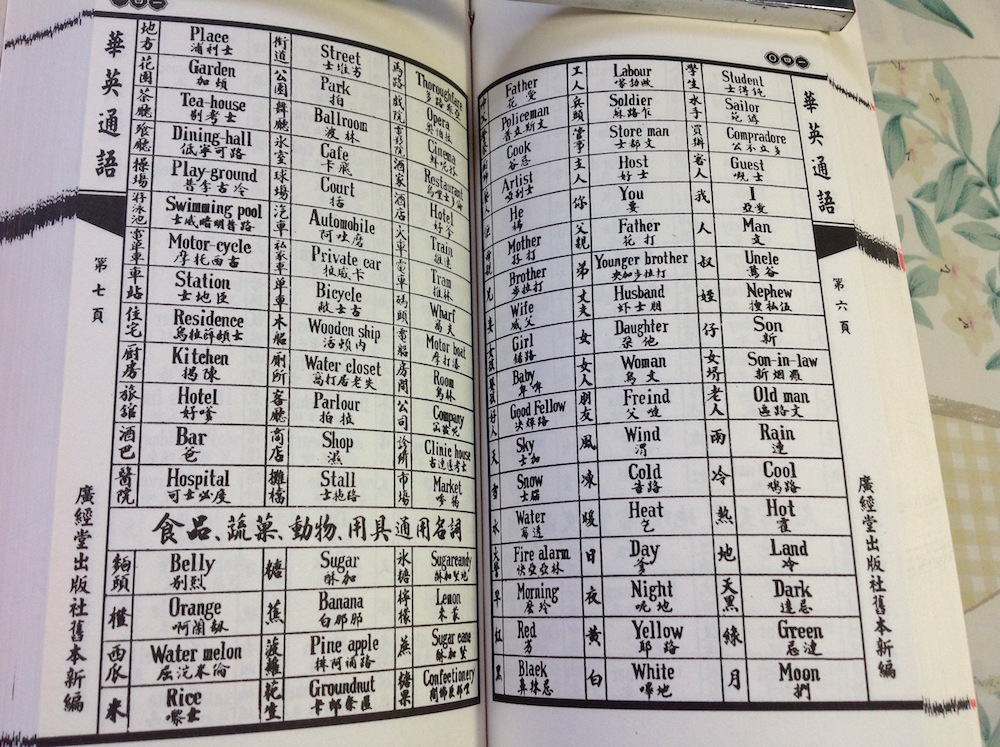English-Cantonese and Hokkien-Malay phrasebooks
« previous post | next post »
Ryan of Singapore sent me photographs of a section from a Chinese almanac that amounts to a ten-page English phrasebook phonetically annotated in Cantonese. Here are two of the pages (as usual, click to embiggen):
The phrasebook, from the current edition of the Guǎngjīng táng 廣經堂 almanac, is entitled Huá-Yīng tōng yǔ 華英通語.
Here are a few sample entries chosen at random:
Water closet — wo1daa1 geoi1lou5sat1 窩打居老失
Man — man4 文
Old man — au1lou6 man4 區路文
Wooden ship — wut6deon6 naap6 活頓內
Compradore — gung1bat1laap6do1 公不立多
I — aa3ngoi3 亞愛
Ballroom — bo1lam4 波林
The meanings of the characters used to transcribe the sounds of the English words have absolutely nothing to do with the meanings of the English words.
This text probably dates to before 1971, as it still mentions Pounds, Shillings, and Pence. Such almanacs are extremely conservative.
Cf.:
- "'Spelling' English in Cantonese" (11/17/13)
- "Spelling with Chinese character(istic)s, pt. 4" (7/4/16) — with links to earlier posts relevant to this subject
The National library of Singapore recently held an exhibition of rare books from its stacks. One of the books was a Hokkien-Malay phrasebook, published in 1883. You can see images of it in this blogpost, "Singapore Diary – From the Stacks at the National Library" (3/24/16), under the section "Do you speak Malay", sub-section "Malay Dictionaries".
The explanatory placard states:
To achieve a more accurate pronunciation of the Malay word, readers are advised to use the Quanzhou or Zhangzhou dialects, as indicated by a triangle or apostrophe mark respectively. The circle means that the word is to be pronounced in the oral rather than literary way.
The placard also gives this interesting note about the editor, Lim Kong Chuan 林光銓 (also known as Lin Heng Nan 林衡南):
As recorded in a book on the genealogy of the Lim clan (1877), the editor Lim Kong Chuan wrote how in 1861 he was so impressed with the work of British lithographers that he decided to learn the skills from them. He then set up Koh Yew Hean Press*, one of the earliest Chinese-run presses in Singapore. The company also printed books in English and jawi (Malay in modified Arabic script).
* 古友軒印務私人有限公司
The dictionary has the title Huá-yí tōng yǔ 華夷通語, which is very similar to that of the phrasebook from the almanac described above, except that Yīng 英 ("English") becomes yí 夷 ("foreign; barbarian; non-Chinese") for "Malay".
Here is a typical entry:
kǔguā 苦瓜 ("bitter gourd")
putlíiǎ 勃里也 — to indicate the sound of Malay "peria" ("bitter gourd")
Bilingual phrasebooks and dictionaries such as the two described in this post are invaluable for research on the language, culture, and economy of diverse places and peoples at various points in time.
